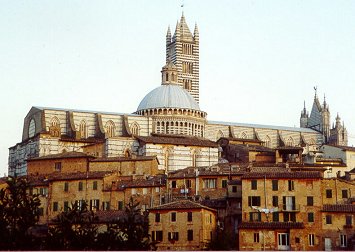Siena, Tuscany, Italy
Created | Updated Feb 28, 2006
Note for Peer Review:
As far as I know, the picture of Siena was only used in a Post entry, not in an Edited Entry, so it should be possible to leave it in.

Siena is one of the most beautiful cities in Italy. It is a walled city, with a striking hilltop setting, surrounded by rolling Tuscan farmland. It is famous for the festival of the Palio, a bareback horserace, but there are many other reasons to visit.
Some History
Beginnings and Medieval Heyday
Siena was founded by the Etruscans, followed by a later Roman settlement. Under the Republican government of the 12th and 13th centuries it became one of the most important cities in Europe, with huge wealth based on local wool and nearby silver mines. This wealth, and rivalry with nearby Florence, encouraged the inhabitants to build the great Cathedral and the Campo, with its amazing belltower. However, the Black Death of 1348 put an end to this prosperity.
Artists and Saints
During this medieval period, the city developed a distinctive school of painting, with Byzantine and Gothic influences and highly religious subjects. The most famous Sienese artists were Duccio and Simone Martini. Their most distinctive subject was the Maestà, with the Madonna painted as a queen in majesty surrounded by a court of saints.
In the troubled years after the Black Death, Siena became equally well known for its two famous saints, associated with two great religious orders. Saint Catherine was a Dominican, who combined a life of spirituality with great influence within the Catholic Church. Saint Bernardino was a Franciscan, who travelled Italy preaching against usury and aristocratic pride.
A Long Decline
In the 15th century, Siena went through a long period of political instability. The city was constantly involved in local wars and disputes, which in the 16th century extended to involve the popes and the Emperor Charles V. In 1555, the Sienese Republic was finally ended by Imperial forces, after a bitter siege. The city was then sold to Florence, and remained a small backwater of Tuscany until the 20th century.
Siena Today
The lack of later development meant that most of medieval Siena has survived until today. The city is built on three ridges, and the steep valleys between still have gardens and fields, even within the city walls. The city is mostly pedestrianised, with narrow streets between the tall brick buildings. It is heavily dependent on tourism. Its main claim to fame economically is as the headquaters of the Monte dei Paschi di Siena, one of the most important banks in Italy, and certainly one of the oldest, dating from 1472.
Principal Sights
The Campo and Belltower
The Campo or 'field' is the name given to the great town square. At the junction of the three hilltop ridges of the city, this 'square' is actually fan-shaped. The ground is paved with a herring-bone pattern in brick. sloping to the gap between two of the three ridges, where the medieval commune built the great Palazzo dei Populi, or town hall. The belltower is known as the Torre del Mangia, and is xxx metres high, giving a wonderful view of the surrounding area. The Palazzo contains important frescoes, including a Maestà by Simone Martini.
The Cathedral
The Duomo or Cathedral has a startling striped appearance, due to bands of black and white marble. The style is a mixture of Romanesque and Gothic. The artistic treasures of the cathedral include the amazingly complex designs of the inlaid pavement, the frescoes by Pinturicchio in the Piccolomini library, and panels by Ghiberti and Donatello on the Baptistry font. The nearby Cathedral Museum contains the Maestà by Duccio, a large altarpiece from 1311 which at the time was the most expensive painting ever commissioned.
The Hospital
xxxx
xxxx
I
text
II
text
III
text
